You may have come across a few ladybugs which do not sport their typical red-and-black spot design. Perhaps it was yellow in color, with some unusual-looking spots? Intrigued? Let’s discuss the yellow ladybug species of this particular kind of ladybug.
What Kind Are Yellow Ladybugs?
Yellow ladybugs do exist and have various species. The marking or spots on their back, (pronotum and elytra) help determine the exact species. Common examples include the 14, 16, and 22 spot yellow ladybug. But not all yellow bugs are ladybugs, so ideally you need to identify them.
Is yours a yellow ladybug? Let’s find out…
Similarly, the variety of markings differs from one species to another and within each species type themselves. As a result, it’s not as simple to answer whether yellow ladybugs belong to a single species.
For Quick Yellow Ladybug Identification
Here’s a quick list of common yellow ladybug species, but they do differ depending on location and they could be good or bad for your garden or crops. See more details on each one further down.
- 14 Spotted Lady Beetle
- 22 Spotted Lady Beetle
- 16 Spotted Lady Beetle
- Spotted Cucumber Beetle
- New Ladybird Beetle
So Many Varieties of Ladybugs
There are more than 450 species of ladybugs in the U.S alone. In the whole world, there are more than 5000 different species of ladybugs. Is it any wonder then that some will turn out to be yellow?
So while it’s not feasible to discuss all of them (although I’m working on that!), there are a few varieties that are distinctive and commonly available in the U.S that we can discuss in general.
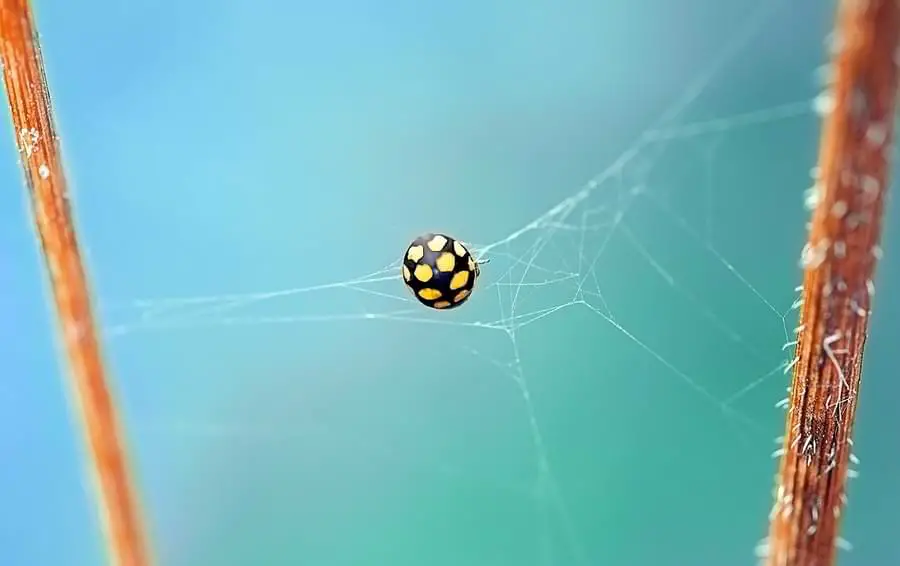
Once you’ve figured out which yellow ladybug variety it is, you might then want to read my article here to determine if it’s a male or female ladybug.
Why Some Ladybugs Are Yellow
The design and variations of ladybirds have been changing and evolving for thousands of years. Different strains change color and design largely to mix with or adapt to their habitats, potential dangers, competitors, and climates. Leading to more extreme color variations.
Types of Yellow Ladybug
Ok, so let’s look at what ladybugs are yellow – and what other insects are yellow so we can try and identify and inform you of the creature you might have in mind (or in front of you!).
14 Spotted Ladybug
We have to be careful here, the 14-spot ladybird actually comes in over 100 different colors, with different markings. So diverse has evolution become that it has split many ways. In most, the spots merge making identification even more difficult.
How to Identify a 14-Spotted Ladybird Beetle
The 14 spotted ladybird, the Propylea quatuordecimpunctata, is yellow, but can also be black, orange, red, or even cream as the main color.
With from 4 to 8 black or even yellow spots, as sometimes the spots ‘meld’ together so much as to appear as though it has yellow spots on a black background. Even forming the shape of an anchor along the side of the Elytra.
The spots can actually be almost rectangular and even form a kind of checkers board effect. Like the other varieties featured here, they’re about 0.11 to 0.18 inches (3mm – 4.5mm) long. The pronotum is usually white or pale yellow. They have yellow to brown colored antennae and legs.
14 Spotted Ladybird Beetles over-winter in various locations, usually low down in vegetation and shrubs.
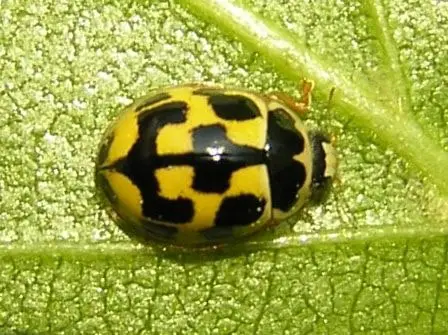
14 spotted Ladybug CC BY-SA 3.0, Link
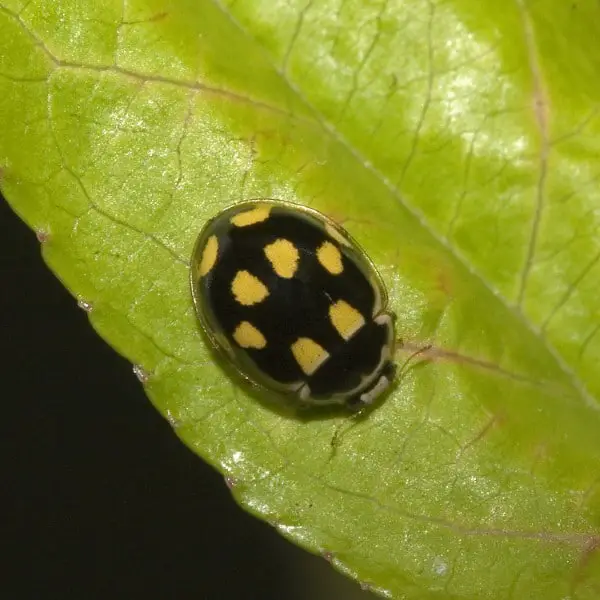
Own work, CC BY-SA 2.5, Link
14 Spotted Ladybug Beetle Habitat
As they populate such a variety of landscapes and climates, they, therefore, live in a variety of habitats; forests and woodlands, meadows and fields, plants, bushes and herbaceous borders, grass, and parks. As well as moss, straw, rotting wood or plants, and even compost.
Like most of the common Ladybug garden varieties, they’re omnivores and eat a variety of food. They’ll invariably be found where there’s a sufficient food source.
Below is a video of a yellow 14-spotted ladybug eating a soybean aphid
Locations of 14 Spotted Ladybird Beetle
This yellow ladybug can be found across Europe, North Africa, and almost all of Asia, stretching up to the Arctic boundaries and through to the far east.
In North America, despite intentional adventive releases of the Ladybug, it has not been established as well, although it can be found in pockets in Canada, Florida, and the Great Lakes.
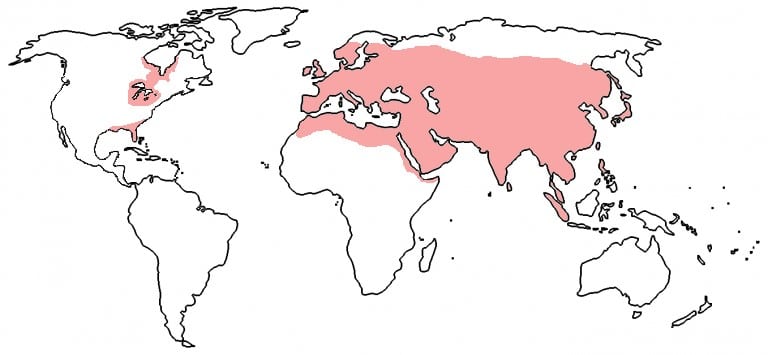
Or maybe it’s…
22 Spotted Ladybug
Kingdom: Animalia > Phylum: Arthropoda > Class: Insecta > Order: Coleoptera > Superfamily: Coccinelloidea > Family: Coccinellidae > Genus: Psyllobora vigintiduopunctata.
As the name suggests, it has twenty-two spots on the body. Although some confuse the 22 spot with the 20 spot (found in the US) or even the 24 spotted ladybirds. Both of which I believe can also be yellow.
But the 20 spot has spots that are melted together –Psyllobora vigintimaculata
This could be because there are seventeen (17) species in the Psyllobora variety (see below), and on some species the spots can blend together, making identification more difficult.
Although they can vary in color from brown, right through to orange. (I’m happy to be corrected on this if someone can confirm or update this detail for me).
22 Spot Ladybug Has 17 Species
Psyllobora bisoctonotata, Psyllobora borealis Casey, Psyllobora bowringi Crotch, Psyllobora confluens Fabricius, Psyllobora conspurcata Boheman, Psyllobora costae Mulsant, Psyllobora intricata Mulsant, Psyllobora lineola Fabricius, Psyllobora marshalli Crotch, Psyllobora nana Mulsant, Psyllobora parvinotata Casey, Psyllobora plagiata Schaeffer, Psyllobora renifer Casey, Psyllobora schwarzi Chapin, Psyllobora variegata, Psyllobora vigintiduopunctata, Psyllobora vigintimaculata.
How to Identify the 22 Spotted Ladybug
Technically the yellow 22 spot though is the Psyllobora vigintiduopunctata. This variety is quite small; measuring about 0.11 to 0.18 inches (3mm – 4.5mm) in length. It has the normal rounded shape of most ladybug species.
The 22-spot Ladybird has a bright yellow back (elytra) and also a yellow (or possibly white) pronotum and head. On its back are 22 distinctly round black spots.
The pronotum also sports 5 black, round spots too. If the spots appear to merge and the Ladybird is larger than given below, then it’s likely you actually have a 14 spotted Ladybug or perhaps a 20 spot ladybird and you may need to try and count them to help be sure.
Its life cycle reflects that of all other Ladybugs. Females are known to lay eggs in batches of up to 40. They’ll then undergo the usual four phases; egg, larva, pupa, and finally, adult.
22 Spotted Ladybug Habitat
They can often be found in grassland, gardens, on the edge of wooded areas, and in towns and parks, often where it may be damp and mildew might thrive as it feeds mostly on Mildew (fungus). They love Hogweed. They’ll often overwinter in areas down low.
Locations of 22 Spotted Ladybug
These are not as rare as one might think, in fact, they’re fairly widespread in the West. It can be found throughout North America, Alaska, Canada, and Mexico.
In the US it’s often referred to as the Alfafa Lady Beetle, even though strangely, there have been few found in that area at all. It’s fairly frequent in England too, but less so in Scotland or Wales. Also found in Europe, Western Asia, and parts of the Middle East.
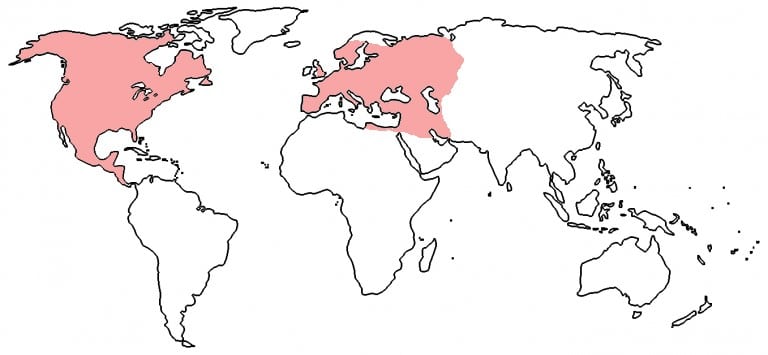
source: Olei [CC BY-SA 2.5], via Wikimedia Commons
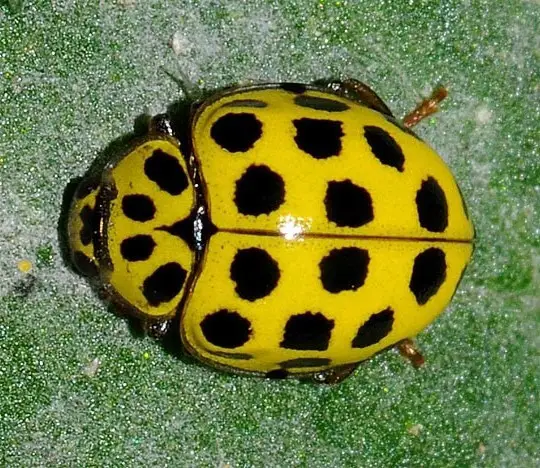
image source: by Heino Cunze
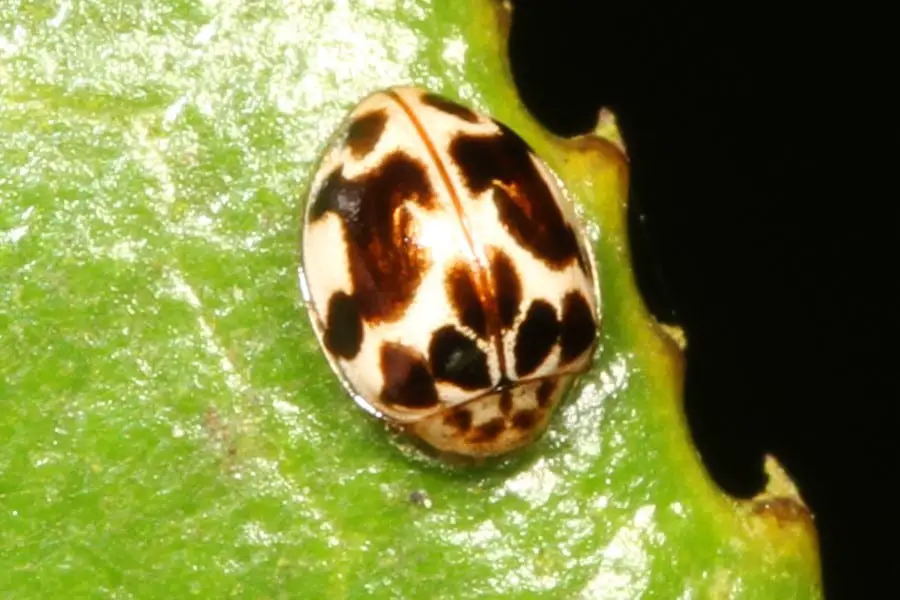
image source: Judy Gallagher – CC BY 2.0, Link
Or there’s a chance it might be…
16 Spotted Ladybug
Officially – Tytthaspis sedecimpunctata. I thought I would add this in as it’s a possibility, but I would say some varieties of the 16 spotted ladybugs are known to be more beige than yellow, it might have a yellow hue if it’s an older beetle.
How to Identify the 16 Spotted Lady Beetle
They’re still small Ladybugs at around 1.11 inches (3 mm) or so, with black spots. Like the 14 spotted variety, they sport a black line down the Elytral Suture (where they meet along the wings center line). Sometimes the spots along the flanks can be seen melted together, almost forming a line along each side.
16 Spotted Ladybug Habitat
Find these in the sand and dune-type areas, grassland, and dry or even marshy meadows. mainly at warmer times of the year so through summer. They feed mainly on Pollen, Nectar, and Fungi – mainly rust fungus. However, it has been recorded as feeding on mites and thrips as well as aphids.
During Winter, the 16 spot ladybirds can gather in large numbers around trees and other wood such as posts, fences, or logs during their diapause phase.
Did You Know…
A group of Ladybugs is called a ‘‘Loveliness of Ladybugs!’
Find out more Amazing Facts About Ladybugs
Locations of the 16 Spotted Ladybug
Found extensively across Europe, E
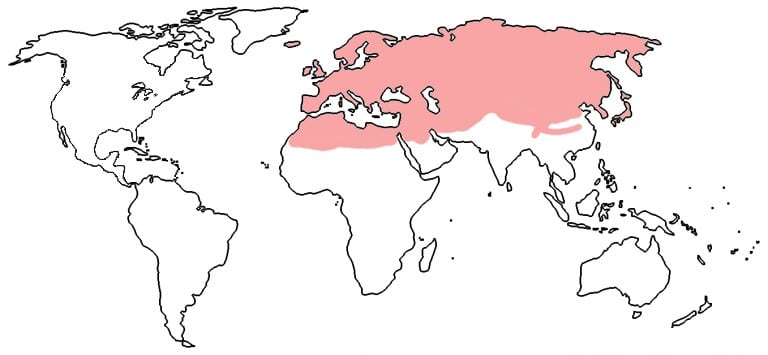
world map depicting the interpreted spread of 16 spotted lady beetle
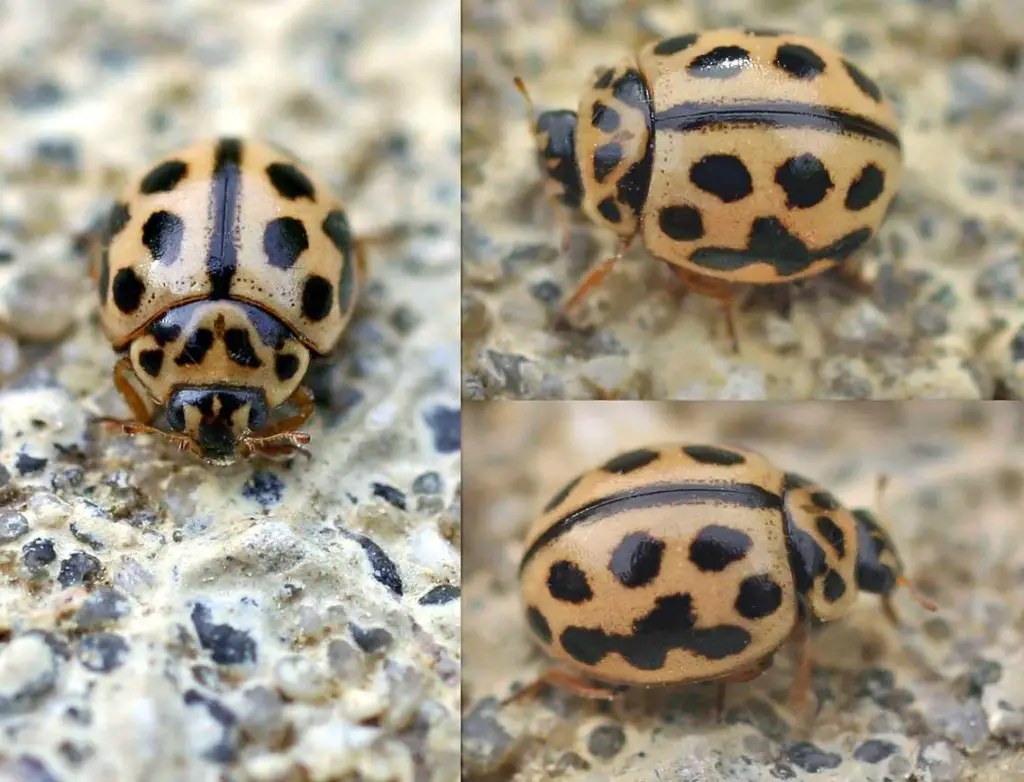
image source: ©entomartIn
Or, unfortunately, it might be a…
Spotted Cucumber Beetle
It might be a
There are three subspecies of Spotted Cucumber Beetle…
- spotted cucumber beetle (southern corn rootworm)
- western cucumber beetle
- western spotted cucumber beetle
How to Identify a Spotted Cucumber Beetle
They look a lot like a Ladybug so you’d be forgiven for thinking it is. The body is more elongated than wide, they’re about 0.2 inches (0.5cm) in length and can be yellow or green with yellow or green Pronotum and head.
Usually, they have 12 black spots – 6 along each Elytron, sometimes clear black spots, and on others, they can be blurred spots. they also have longer antennae. Their Larva is yellow and is grub/maggot-like in appearance.
Spotted Cucumber Beetle Habitat
Spotted Cucumber Beetles are mostly native to North America and are considered a major pest in agriculture. The Larvae form is called the Southern Corn Rootworm as it notoriously attacks corn crops. It burrows into the roots of younger plants which either stunts their growth or kills them from the root upward.
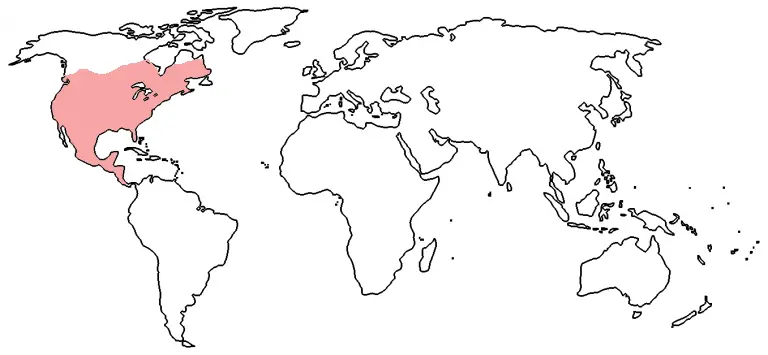
world map depicting the interpreted spread of 16 spotted lady beetle
Adults eat and damage the leaves of agricultural and garden crops, including cucumbers, cotton, and all types of beans including soybeans.
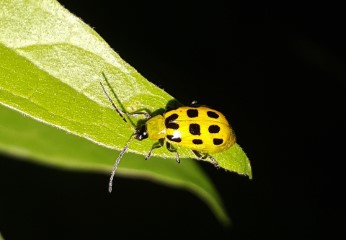
Or Just Plain Yellow Could be a…
Newly Emerged Ladybug
A newborn ladybug can be of any color depending on its species. They can be pink, red, orange, yellow, or even black. As a result, a particular color of ladybug species does not indicate the stage of their lifecycle.
The spots on their back, though, can be used to determine whether they’re newly transformed ladybugs or not. Newly emerged ladybugs tend to have light or faded spots since the hard shell protecting the inner wings is not yet fully matured. As a result, the colors are not as saturated.
Are Yellow Ladybugs Poisonous?
Poisonous To Humans?
No. In fact, ladybugs, in general, are not poisonous at all. The most commonly found species of red-and-black-dotted ladybugs are actually friendly and more likely to turn and run than try to bite large creatures. They’re not aggressive. Similarly, yellow ladybugs are not poisonous either.
Their blood, emitted whilst being threatened or attacked, can have a toxic effect on some smaller insects/animals.
But while it’s not unheard of, it is extremely rare for a human to show any reaction to a bite. At the most, a ladybug bite can cause a mild rash, if you’re allergic. If in doubt or you experience a greater reaction to a bite then seek medical attention.
Poisonous To Animals?
Their mandibles are used to bite into soft-bodied prey like mites, aphids, and leaves and lack the strength to puncture human or animal skin – they merely graze it.
However, if you’re concerned in any way you should seek medical advice/attention. Pets who are prone to eating or rolling around groups of hibernating Ladybugs may run the risk of being bitten, particularly by the more aggressive variety. but this should not result in any long-term effects. If in doubt, seek a vet’s advice.
Do Yellow Ladybugs Bite?
They can bite, though they do not generally. A ladybug bite is likely to hurt less than a needle prick. Most ladybugs will avoid biting in the first place, but some species are more aggressive. In such cases, you might experience slight itching or rashes.
Again, if you’re the slightest bit concerned you should seek medical advice/attention. You can find out more information on Ladybugs biting in my article – Do Ladybugs Bite?
What Yellow Ladybugs Symbolise
Different countries and cultures assess colors differently. While some cultures take the color yellow to stand for positivity and prosperity, others prefer the red color.
For example, Australia takes yellow ladybugs as a symbol of happiness and success. It is thought to be the forebears of celebration and prosperity.
Ever Dream About Ladybugs?
Find Out What it means
Other cultures might not have any particular meaning or symbolic significance associated with the insect.
However, given how ladybugs have been a huge help to farmers worldwide, they are often taken as adorable pets and symbols of positivity.
Children like them due to their bright colors and appearance. Find out lots more meanings in my article What Ladybugs mean – in love, luck, signs,
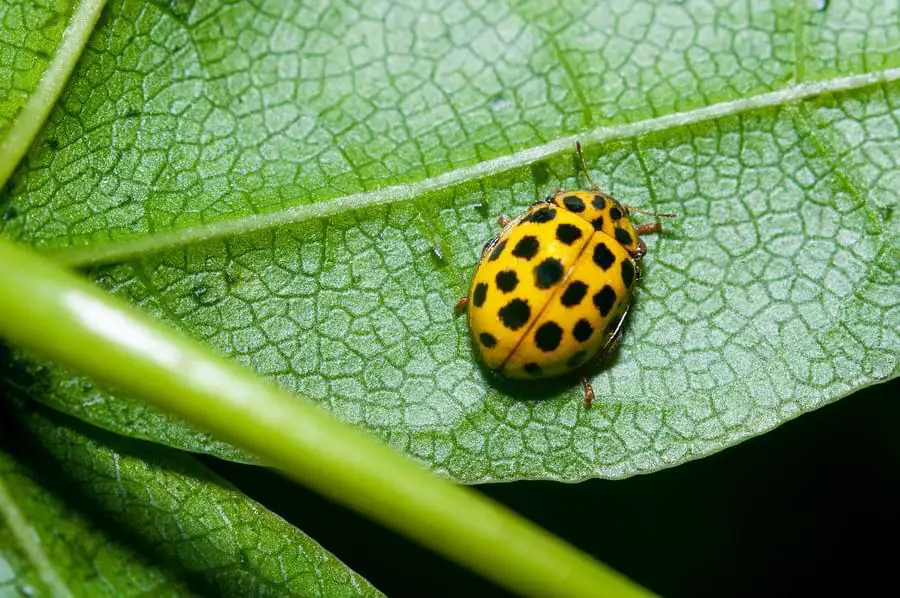
Yellow Ladybug – Wrapping Up
Yellow ladybugs do not belong to one particular species. There are more than one species that have yellow or yellow-like body color.
As a result, it’s different to identify a ladybug species just by color. In fact, ladybugs are so close to other beetle families, that a few taxonomic markings such as cheek spots, are the only differentiators and sometimes it’s not even possible to tell with the naked eye!
I hope this article helped you to identify whatever it is you’re looking at – or wondering about. I often see a beetle and wonder what it is or what family it comes from, and more importantly, whether it’s good for my garden or not.
Don’t forget to check out my other articles, plus check the practical learning aids below to help homeschool your children.
Yellow Ladybug – Related Questions:
Difference between Yellow and Black Ladybugs Black ladybugs and yellow ladybugs are part of the same family, but their diet, behavior, and taxonomic markings may differ. For example, most ladybug species are omnivores (eating plants and insects), but some species are strictly herbivores and do not venture outside their plant-based diet.
Are black ladybirds with yellow spots poisonous? No, there are no Ladybugs poisonous to humans or pets which includes Black Ladybugs. They can bite, and some species are more aggressive than others. But they don’t t

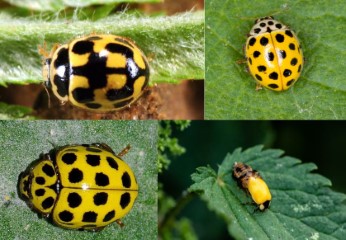

Could I sent you a photo of the ladybug in my yard and you tell me exactly what kind it is? I’ve never seen these before.
Thank you Joy, indeed, I’ll do my best. Please email to hello at ladybugplanet dot com
I have a video and pics of a yellow black spotted ladybug. I have never seen.ome before. It was pretty kewl.and had attached to my sports jacket after walking the dykes in Pitt Meadows.BC. It came home in my convertible lol…then saw it later on my sleeve. I let it go outside my home…and took video and pics. How can I send it to you. Thank you for the info. Cindy Berg..Vancouver Canada
Hey Cindy, thanks for the comment. Sounds intriguing! You’ve had a nice lucky Ladybug meaning!
Please send it to this mail address and I’ll see if I can help identify it.
Please can you help Identify if I have larvae/pupae of a lady bug (I hope) I have in clusters on a tree in my yard if I send a photo
Hello,
Your page was very helpful in identifying a 14 spotted yellow ladybug that was crawling on my car in Little Falls, NY. I had never seen one before and didn’t know there were other colors than red! I suspect it is on the edge of its normal range if not outside it?
Many thanks!
Hi, excellent content! I have a picture of a tiny one, looks a lot like the 14 spotted although a little different. The thing is, I saw it in Venezuela. It is possible?
What about spotless yellow ladybug? Is there any information about it?
Good question. Spotless I would usually assume to be newly born (yellow and without spots – yet). But there are hundreds of varieties, so it’s some less well known species might be without spots entirely 🙂